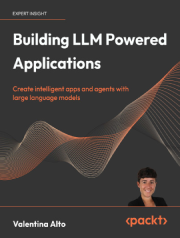
عنوان:
Building LLM Powered Applications
نویسنده:
Valentina Alto
انتشارات:
Packt Publishing
تاریخ انتشار:
2024
حجم:
4.51MB
معرفی کتاب:" ساخت برنامههای مبتنی بر LLM: ایجاد اپلیکیشنها و عاملهای هوشمند با مدلهای زبان بزرگ"
Building LLM Powered Applications یک راهنمای عملی و جامع برای ایجاد اپلیکیشنها و عاملهای هوشمند با مدلهای زبان بزرگ (LLM) مانند GPT-3.5، GPT-4، Llama 2 و Falcon LLM است. این کتاب نحوه استفاده از LangChain و ابزارهای مرتبط را برای ساخت برنامههای هوشمند و پیشرفته آموزش میدهد.
ویژگیهای کلیدی:
- ادغام مدلهای LLM در برنامههای واقعی
- استفاده از LangChain برای هماهنگی LLMها و اجزای آنها درون برنامهها
- درک تکنیکهای پایه و پیشرفته مهندسی Prompt
توضیحات کتاب:
کتاب Building LLM Powered Applications به مفاهیم پایه، فناوریهای پیشرفته و کاربردهای عملی LLMها میپردازد و مسیر ظهور مدلهای بنیادین بزرگ (LFMs) را هموار میکند، که مرزهای تواناییهای هوش مصنوعی را گسترش میدهند.
کتاب با معرفی جامع مدلهای LLM آغاز میشود، سپس چارچوبهای معماری مرسوم شامل مدلهای اختصاصی (GPT-3.5/4) و مدلهای متنباز (Falcon LLM) بررسی و نقاط قوت و تفاوتهای آنها تحلیل میشود.
با تمرکز بر چارچوب سبک Python محور LangChain، شما در فرایند ایجاد عاملهای هوشمندی راهنمایی میشوید که قادر به استخراج اطلاعات از دادههای غیرساختاریافته و تعامل با دادههای ساختاریافته هستند. علاوه بر این، کتاب وارد حوزه LFMs میشود که فراتر از مدلسازی زبان، وظایف و مدالیتههای مختلف هوش مصنوعی مانند بینایی و صوت را شامل میشوند.
آنچه یاد خواهید گرفت:
- بررسی اجزای اصلی معماری LLM، شامل بلوکهای Encoder-Decoder و Embeddingها
- درک ویژگیهای منحصربهفرد LLMها مانند GPT-3.5/4، Llama 2 و Falcon LLM
- استفاده از هماهنگکنندههای هوش مصنوعی مانند LangChain با Streamlit برای فرانتاند
- آشنایی با اجزای LLM شامل حافظه، Promptها و ابزارها
- یادگیری استفاده از دانش غیرپارامتریک و پایگاههای داده برداری (Vector Databases)
- درک تأثیر LFMs بر تحقیقات و کاربردهای صنعتی هوش مصنوعی
- سفارشیسازی LLMها با Fine Tuning
- آشنایی با پیامدهای اخلاقی برنامههای مبتنی بر LLM
مخاطبان کتاب:
این کتاب برای مهندسین نرمافزار و دانشمندان داده که به دنبال راهنمایی عملی برای استفاده از LLMها در ساخت برنامهها هستند مناسب است. همچنین رهبران فنی، دانشجویان و پژوهشگرانی که به موضوعات کاربردی LLM علاقهمندند، از مطالعه آن بهرهمند خواهند شد.
کتاب فرض نمیکند که خواننده تجربه قبلی با LLM داشته باشد، اما داشتن اصول پایهای یادگیری ماشین و مهندسی نرمافزار برای درک کامل محتوا توصیه میشود.
درباره نویسنده:
نویسندگان کتاب، متخصصین هوش مصنوعی و توسعهدهندگان برجسته هستند که تجربه عملی در کار با GPT و مدلهای متنباز مانند Falcon LLM و Llama 2 دارند و تمرکز آنها بر ایجاد ابزارهای کاربردی برای توسعهدهندگان است.
فهرست مطالب
- Cover
- Copyright
- Contributors
- Table of Contents
- Preface
- Chapter 1: Introduction to Large Language Models
- What are large foundation models and LLMs?
- Most popular LLM transformers-based architectures
- Training and evaluating LLMs
- Base models versus customized models
- Summary
- References
- Chapter 2: LLMs for AI-Powered Applications
- How LLMs are changing software development
- The copilot system
- Introducing AI orchestrators to embed LLMs into applications
- Summary
- References
- Chapter 3: Choosing an LLM for Your Application
- The most promising LLMs in the market
- Beyond language models
- A decision framework to pick the right LLM
- Summary
- References
- Chapter 4: Prompt Engineering
- Technical requirements
- What is prompt engineering?
- Principles of prompt engineering
- Advanced techniques
- Summary
- References
- Chapter 5: Embedding LLMs within Your Applications
- Technical requirements
- A brief note about LangChain
- Getting started with LangChain
- Working with LLMs via the Hugging Face Hub
- Summary
- References
- Chapter 6: Building Conversational Applications
- Technical requirements
- Getting started with conversational applications
- Developing the front-end with Streamlit
- Summary
- References
- Chapter 7: Search and Recommendation Engines with LLMs
- Technical requirements
- Introduction to recommendation systems
- Existing recommendation systems
- How LLMs are changing recommendation systems
- Implementing an LLM-powered recommendation system
- Developing the front-end with Streamlit
- Summary
- References
- Chapter 8: Using LLMs with Structured Data
- Technical requirements
- What is structured data?
- Getting started with relational databases
- Implementing the DBCopilot with LangChain
- Developing the front-end with Streamlit
- Summary
- References
- Chapter 9: Working with Code
- Technical requirements
- Choosing the right LLM for code
- Code understanding and generation
- Act as an algorithm
- Leveraging Code Interpreter
- Summary
- References
- Chapter 10: Building Multimodal Applications with LLMs
- Technical requirements
- Why multimodality?
- Building a multimodal agent with LangChain
- Option 1: Using an out-of-the-box toolkit for Azure AI Services
- Option 2: Combining single tools into one agent
- Option 3: Hard-coded approach with a sequential chain
- Comparing the three options
- Developing the front-end with Streamlit
- Summary
- References
- Chapter 11: Fine-Tuning Large Language Models
- Technical requirements
- What is fine-tuning?
- When is fine-tuning necessary?
- Getting started with fine-tuning
- Summary
- References
- Chapter 12: Responsible AI
- What is Responsible AI and why do we need it?
- Responsible AI architecture
- Regulations surrounding Responsible AI
- Summary
- References
- Chapter 13: Emerging Trends and Innovations
- The latest trends in language models and generative AI
- Companies embracing generative AI
- Summary
- References
- Packt Page
- Other Books You May Enjoy
- Index
مشخصات
نام کتاب
Building LLM Powered Applications: Create intelligent apps and agents with large language models
نویسنده
Valentina Alto
انتشارات
Packt Publishing
تاریخ انتشار
2024
ISBN
9781835462317
تعداد صفحات
343
زبان
انگلیسی
فرمت
حجم
4.51MB
موضوع
Computers > Algorithms and Data Structures: Pattern Recognition
